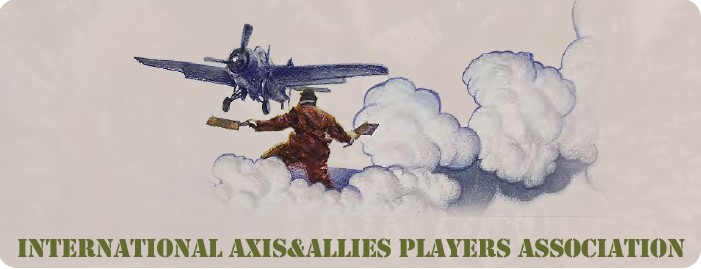Welcome to the IAAPA
 Welcome to the International Axis and Allies Players Association — the oldest Axis and Allies Gaming Organization in the world!!! If you love the game and are looking for more than an occasional weekend with friends, then you have come to the right place!
Welcome to the International Axis and Allies Players Association — the oldest Axis and Allies Gaming Organization in the world!!! If you love the game and are looking for more than an occasional weekend with friends, then you have come to the right place!
With many members looking for opponents you will always find someone with the time to play the game when you want to play. By playing games with other IAAPA members, you will not only be able to gauge your abilities against the best players in the world, but you will be rewarded for your achievements, improving your worldwide lifetime rank in both of our Ranking/Rating databases in a fair, friendly and competitive environment where the highest standards of conduct and gamesmanship are the rule.
 Play by email (PBEM) provides the ideal means for individuals to satisfy their gaming hobby without having to set aside long blocks of time to play the games that they love. Our easy-to-use dice server automatically rolls out battles for members, and provides a verification log and emails the results to both players.
Play by email (PBEM) provides the ideal means for individuals to satisfy their gaming hobby without having to set aside long blocks of time to play the games that they love. Our easy-to-use dice server automatically rolls out battles for members, and provides a verification log and emails the results to both players.
We currently support both Axis and Allies Classic (Original, aka 1984) and Axis and Allies Revised (AAR, aka 4th edition, aka A&A 2004) game play. Other versions maybe be added in the future if demands warrant expansion.
So please look around our site, and when you are ready, take The Final Hurdle and join the ranks of the best Play by E-mail Axis and Allies organization in the world.
Welcome Back to our Returning Members!
We would like to welcome the following members back to the IAAPA family:
Molvas - last seen in 2015 after a crushing defeat to Spud in the 2014 Masters, GEN*** Molvas is back for revenge. His tourney triumphs include Summer Open 2009 and 2012, Masters 2011, Spring AAR 2010, 2011 and 2014 and the Fall AAR in 2009. In addition he was crowned Tournament Player of the Year in 2012.
Diecaster - back after an 11 year absence, Diecaster is a GEN* with an impressive 27-8 record. In the past he has played almost exclusively 2nd edition, hopefully we can get him to jump into some AAR games.
Byrons_Brigade - returning after a 19 year absence, MAJ Byrons_Brigade is the Summer Open champion from 2001. He was very active in the club and a regular insightful contributor on the message boards until real life got in the way.
GroeFaZ - it's been acht Jarhe since we last saw our previous Minister of Tournaments on the battlefield. His Battlefield Reviews can be seen here. He is looking to add to his 2008 Combat Pro tournament title. He was so popular that he was profiled twice; once here and the second time here. He is, in his own words, the best field marshal of all time. Nothing like painting a target on your back, huh?
Daninja - from our Australian regiment, Col Daninja returns to the IAAPA family after a 17 year absence. He was one of our archivists, check out his Snapshots in Time here.
KenBell - one of our best and highest ranking players ever, GEN**** KenBell brings his 84-18 record back after a 16 year break. Even after all this time I doubt there is any rust on this guy, but it might be your best chance to beat him!
SGT_BILL - another one of our wayward AAR experts, he could only stay away for a couple of years, and we missed him. Welcome back SGT_BILL (who is a LT now, by the way).
Great to have you all back, and may your dice roll fair.
IAAPA is now FREE!
IAAPA, the best Axis and Allies gaming community in the world, is now even better because it is FREE. Dues are no longer required. Play one game, play a hundred, no cost.

Recruits will still need to pass the Final Hurdle, but once cleared can commence a full unrestricted membership. If you are ready to become part of the IAAPA community, JOIN NOW.




